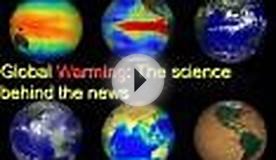Science behind global warming

How do we know carbon dioxide concentrations have increased?
The concentrations of carbon dioxide and other greenhouse gases in atmospheric samples have been measured continuously since the late 1950s. Since then, carbon dioxide concentrations have increased steadily from about 315 parts per million (ppm, or molecules of carbon dioxide per million molecules of dry air) in the late 1950s to about 385 ppm now, with small spatial variations away from major sources of emissions. For the more distant past, we can measure atmospheric concentrations of greenhouse gases in bubbles of ancient air preserved in ice (e.g., in Greenland and Antarctica). Ice core records currently go back 650, 000 years; over this period we know that carbon dioxide concentrations have never been higher than they are now. Before the industrial revolution, they were about 280 ppm, and they have varied naturally between about 180 ppm during ice ages and 300 ppm during warm periods (Fig. 1). Concentrations of methane and nitrous oxide have likewise increased since the industrial revolution (Fig. 2) and, for methane, are higher now than they have been in the 650, 000 years before the industrial revolution.
 Figure 2. Greenhouses gases then and now.
Figure 2. Greenhouses gases then and now.
How do we know the increase in carbon dioxide
concentrations is caused by human activities?
There are several lines of evidence. We know approximately how much carbon dioxide is emitted as a result of human activities. Adding up the human sources of carbon dioxide — primarily from fossil fuel burning, cement production, and land use changes (e.g., deforestation) — one finds that only about half the carbon dioxide emitted as a result of human activities has led to an increase in atmospheric concentrations. The other half of the emitted carbon dioxide has been taken up by oceans and the biosphere — where and how exactly is not completely understood: there is a “missing carbon sink.”
Human activities thus can account for the increase in carbon dioxide concentrations. Changes in the isotopic composition of carbon dioxide show that the carbon in the added carbon dioxide derives largely from plant materials, that is, from processes such as burning of biomass or fossil fuels, which are derived from fossil plant materials. Minute changes in the atmospheric concentration of oxygen show that the added carbon dioxide derives from burning of the plant materials. And concentrations of carbon dioxide in the ocean have increased along with the atmospheric concentrations, showing that the increase in atmospheric carbon dioxide concentrations cannot be a result of release from the oceans. All lines of evidence taken together make it unambiguous that the increase in atmospheric carbon dioxide concentrations is human induced and is primarily a result of fossil fuel burning. (Similar reasoning can be evoked for other greenhouse gases, but for some of those, such as methane and nitrous oxide, their sources are not as clear as those of carbon dioxide.)


|
On thin ice: drowning polar bears? Stranded walrus calves? A Science World editor travels north to report on the effects of global warming.: An article from: Science World Book (Thomson Gale) |